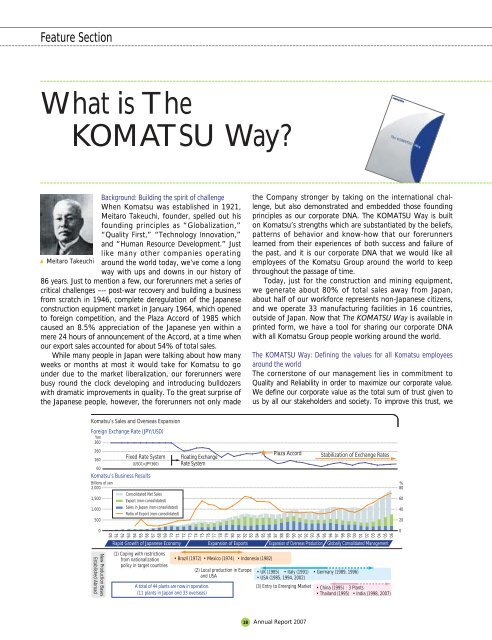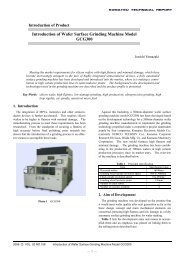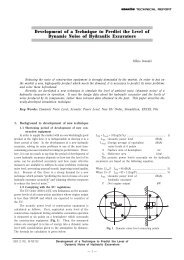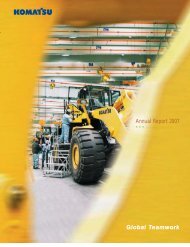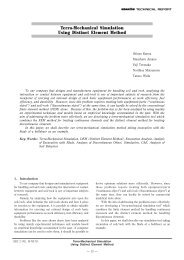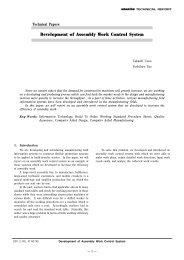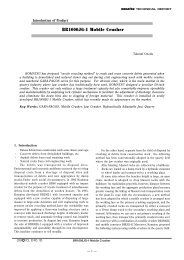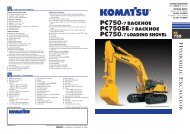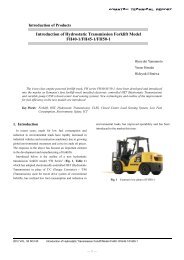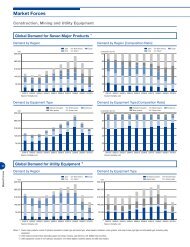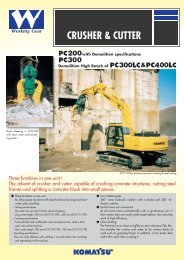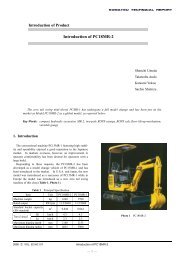Feature Section : The Komatsu Way
Feature Section : The Komatsu Way
Feature Section : The Komatsu Way
Create successful ePaper yourself
Turn your PDF publications into a flip-book with our unique Google optimized e-Paper software.
<strong>Feature</strong> <strong>Section</strong><br />
What is <strong>The</strong><br />
KOMATSU <strong>Way</strong>?<br />
Background: Building the spirit of challenge<br />
When <strong>Komatsu</strong> was established in 1921,<br />
Meitaro Takeuchi, founder, spelled out his<br />
founding principles as “Globalization,”<br />
“Quality First,” “Technology Innovation,”<br />
and “Human Resource Development.” Just<br />
like many other companies operating<br />
Meitaro Takeuchi around the world today, we’ve come a long<br />
way with ups and downs in our history of<br />
86 years. Just to mention a few, our forerunners met a series of<br />
critical challenges –-- post-war recovery and building a business<br />
from scratch in 1946, complete deregulation of the Japanese<br />
construction equipment market in January 1964, which opened<br />
to foreign competition, and the Plaza Accord of 1985 which<br />
caused an 8.5% appreciation of the Japanese yen within a<br />
mere 24 hours of announcement of the Accord, at a time when<br />
our export sales accounted for about 54% of total sales.<br />
While many people in Japan were talking about how many<br />
weeks or months at most it would take for <strong>Komatsu</strong> to go<br />
under due to the market liberalization, our forerunners were<br />
busy round the clock developing and introducing bulldozers<br />
with dramatic improvements in quality. To the great surprise of<br />
the Japanese people, however, the forerunners not only made<br />
the Company stronger by taking on the international challenge,<br />
but also demonstrated and embedded those founding<br />
principles as our corporate DNA. <strong>The</strong> KOMATSU <strong>Way</strong> is built<br />
on <strong>Komatsu</strong>’s strengths which are substantiated by the beliefs,<br />
patterns of behavior and know-how that our forerunners<br />
learned from their experiences of both success and failure of<br />
the past, and it is our corporate DNA that we would like all<br />
employees of the <strong>Komatsu</strong> Group around the world to keep<br />
throughout the passage of time.<br />
Today, just for the construction and mining equipment,<br />
we generate about 80% of total sales away from Japan,<br />
about half of our workforce represents non-Japanese citizens,<br />
and we operate 33 manufacturing facilities in 16 countries,<br />
outside of Japan. Now that <strong>The</strong> KOMATSU <strong>Way</strong> is available in<br />
printed form, we have a tool for sharing our corporate DNA<br />
with all <strong>Komatsu</strong> Group people working around the world.<br />
<strong>The</strong> KOMATSU <strong>Way</strong>: Defining the values for all <strong>Komatsu</strong> employees<br />
around the world<br />
<strong>The</strong> cornerstone of our management lies in commitment to<br />
Quality and Reliability in order to maximize our corporate value.<br />
We define our corporate value as the total sum of trust given to<br />
us by all our stakeholders and society. To improve this trust, we<br />
<strong>Komatsu</strong>‘s Sales and Overseas Expansion<br />
Foreign Exchange Rate (JPY/USD)<br />
Yen<br />
360<br />
260<br />
Fixed Rate System Floating Exchange<br />
160<br />
(USD1=JPY360) Rate System<br />
60<br />
<strong>Komatsu</strong>’s Business Results<br />
Billions of yen<br />
2,000<br />
Consolidated Net Sales<br />
1,500<br />
Export (non-consolidated)<br />
1,000<br />
Sales in Japan (non-consolidated)<br />
Ratio of Export (non-consolidated)<br />
500<br />
Plaza Accord<br />
Stabilization of Exchange Rates<br />
%<br />
80<br />
60<br />
40<br />
20<br />
0<br />
’60<br />
’61<br />
’62<br />
’63<br />
’64<br />
’65<br />
’66<br />
’67<br />
’68<br />
’69<br />
’70<br />
’71<br />
’72<br />
’73<br />
’74<br />
’75<br />
’76<br />
’77<br />
’78<br />
’79<br />
’80<br />
’81<br />
’82<br />
’83<br />
’84<br />
’85<br />
’86<br />
’87<br />
’88<br />
’89<br />
’90<br />
’91<br />
’92<br />
’93<br />
’94<br />
’95<br />
’96<br />
’97<br />
’98<br />
’99<br />
’00<br />
’01<br />
’02<br />
’03<br />
’04<br />
’05<br />
’06<br />
Rapid Growth of Japanese Economy Expansion of Exports Expansion of Overseas Production Globally Consolidated Management<br />
0<br />
New Production Bases<br />
Established Abroad<br />
(1) Coping with restrictions<br />
from nationalization<br />
policy in target countries<br />
A total of 44 plants are now in operation.<br />
(11 plants in Japan and 33 overseas)<br />
• Brazil (1972) • Mexico (1974) • Indonesia (1982)<br />
(2) Local production in Europe<br />
and USA<br />
• UK (1985) • Italy (1991) • Germany (1989, 1996)<br />
• USA (1985, 1994, 2002)<br />
(3) Entry to Emerging Market • China (1995) : 3 Plants<br />
• Thailand (1995) • India (1998, 2007)<br />
18 Annual Report 2007


